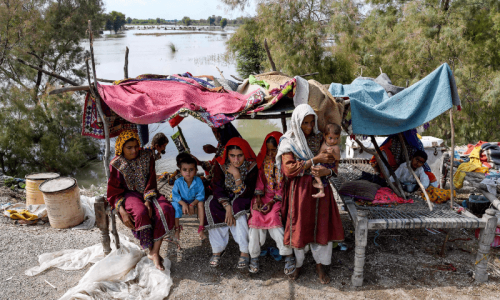Water flows from Manchhar Lake continued to be released into the Indus River on Monday as the lake’s level has risen to keep it within safer limits, according to officials.
The water level of Manchhar Lake was 117.1RL as per the 6am reading recorded of the gauge at the Manchhar Containing Bund (MCB) RD-62 on Sunday, according to Mancchar executive engineer Imtiaz Abro.
“This level has now dropped to 117RL on Monday noon. Overall level of Manchhar lake as far as its embankments are concerned is safe. Water from the lake is being released from both sources: Aral head and Aral tail channels’ regulators,” he told Dawn.com.
According to him, the 117.1RL in the lake remains the highest this season so far and future flows are directly dependent on weather forecasts and conditions.
The lake attained 123.5RL in September 2022 which was said to be the highest. The heavy discharge of floodwaters from Balochistan and water from hill torrents in Sindh had forced irrigation authorities to give two relief cuts on the banks of the Manchhar.
The Indus River has remained in the medium flood stage for the last several days whereas upstream barrages of Sukkur remain in normal position. On the other hand, Guddu is again having a low flood after two barrages passed peaks of medium flood last month.
Manchhar Lake is located around 171 kilometres northwest of Hyderabad and falls in Sehwan taluka of Jamshoro and Johi taluka of Dadu districts. The Flood Protective (FP) bund that begins from upper Sindh’s Qambar-Shahdadkot district, borders Balochistan and ends at Manchhar Lake.
Now, eight gates of Aral Wah’s head regulator pass the lake’s flows into the Indus River while the tail regulator’s five gates are also opened to release more water and keep the lake’s banks safe.
“We operated the Aral head regulator from Friday night while the Aral tail regulator was releasing water for the last two days,” Abro said.
He confirmed that around 6,000 cusecs of water were being released from the Aral tail regulator and around 3,000 cusecs from the Aral head.
“Aral tail regulator passes more water due to its old bed level’s design where Aral head regulator is newly built and that’s why it is passing low flows in safe limits,” Abro said.
According to Sindh Flood Emergency Rehabilitation Project (SFERP) official Zahid Sheikh, a retired chief engineer, the Aral head regulator now has 14 gates to have 52,500 cusecs discharge — up by 42,000 cusecs — from its previous designed discharge of 10,500 cusecs.
The structure of the Aral head regulator has been relocated around 2,300 feet upstream from its previous location off the Indus highway near Sehwan city, he said.
Meanwhile, Dr Ahsan Siddiqui is a water technologist who has been monitoring Manchhar Lake’s flows that end up in the Indus River for around two decades.
Such monitoring began under judicial oversight when in May 2004 over 40 deaths of people were reported in Hyderabad and other districts after they consumed the Indus River’s water mixed with contaminated flows of Manchhar Lake.
The presence of toxic effluent in the lake is due to release from the Main Nara Valley Drain (MNVD) that brings those flows from upper Sindh and Balochistan.
MNVD is still controlled by Wapda and according to Abro, no gauge is fixed there to check the flow quantum that it is bringing and releasing into the lake.
According to Dr Siddiqui, he had permitted irrigation authorities to release water from Manchhar into the Indus River. “Currently, flows in the Indus River remain ideal and there is a marginal difference in the quality of water from the lake and Indus,” Dr Siddiqui said.
Under his monitoring of the water quality of the Indus River, a ratio of 1:20 is to be maintained. “If the value of total dissolved salts (TDS) reaches 480 particles per million (PPM) at AD Baloch point we ask irrigation authorities to stop releasing the lake’s water into the Indus,” he said.
AD Baloch is a point located around 5km from where the lake’s water is released through the Aral tail regulator and after covering this distance the dilution of water could be easily studied through water analysis, according to Dr Siddiqui.
He said that the TDS value at Kotri barrage upstream as per a recent water analysis put it at 148PPM while at Aral tail it was 197 to 220PPM on Sunday. “There is not much difference in quality of water at two locations,” he said.
He added that it was primarily turbidity that was heavy in river water and that it could be controlled by civic agencies in the filtration process.
The Kotri Barrage sample is collected and analysed because the Hyderabad Water & Sewerage Corporation lifts water to meet the drinking water needs of Hyderabad city and collects it in the corporation’s lagoons located off Jamshoro road.
Discharges at the barrage recorded at 6pm on Monday showed that Guddu had a low flood of 208,291 cusecs downstream while Sukkur Barrage had passed 170,650 cusecs of water for Kotri Barrage where upstream discharge was recorded at 340,818 cusecs and 335,618 cusecs downstream.
The irrigation authorities began feeding Manchhar Lake with Indus River water through the Aral head regulator last month. Considering the 2022 experience of heavy flooding and rains, however, the authorities stopped these flows going into the lake to avoid any threat to its embankment.
The release of Indus River water led to euphoria among fishermen whose livelihood depends on Manchhar Lake’s freshwater as they are bound to have decent catch but when the lake starts receiving toxic effluent, it kills the fish inside the lake thus depriving them of their source of livelihood.
According to Abro, a reduction of three decimals was also recorded at the Dadu-Moro bridge downstream Sukkur barrage. It was 127.5RL at 6am and 127.2 at 6pm on Sunday while the Sukkur Barrage was having normal floods now.
“A recession is seen at this location of Indus River which is recorded at 126.8RL, showing a visible reduction. As far as Manchhar’s flows’ releases are concerned impact of this recession will be observed Tuesday morning,” he said.
Two years back on Sept 4, 2022, two major relief cuts had to be given at RD-14 and RD-52 of Manchhar Lake which had attained a maximum level of 123.5RL — a dangerous rise that had threatened its banks’ safety. Gushing floodwaters that were released from relief cuts had inundated all ten union councils falling in Sehwan taluka.
Interestingly, the Indus River at Kotri Barrage had passed more flood discharge than Guddu and Sukkur then. It is usually quite unusual for a barrage located downstream to receive or pass bigger flows when compared with its upstream barrages. Guddu and Sukkur, usually pass more volume of floodwater during floods as was recorded in 2010 and 2015.
In 2022 the situation, however, remained different. A higher discharge was noted at Kotri when compared with Guddu and Sukkur. Kotri barrage had passed high flood in 2022, recording upstream discharge of 626,193 cusecs and 600,018 cusecs downstream on Sept 11, 2022.
And when compared with Guddu and Sukkur the former had passed 550,122 cusecs downstream on Aug 23 and the latter passed a flow of 579,753 cusecs downstream on Aug 25, 2022.
Those unusual flows past downstream Kotri were attributed to floodwaters received from Balochistan besides hill torrents and flows from MNVD, according to irrigation authorities. MNVD had burst its banks while the FP bund had also developed breaches in 2022.
All these flows first ended up in Manchhar Lake which was located downstream Sukkur barrage.
Last year, the Kotri barrage had received a discharge of 258,153 cusecs upstream and 220,908 cusecs downstream on Aug 9. Kotri barrage has a designed discharge capacity of 875,000 cusecs















































Dear visitor, the comments section is undergoing an overhaul and will return soon.